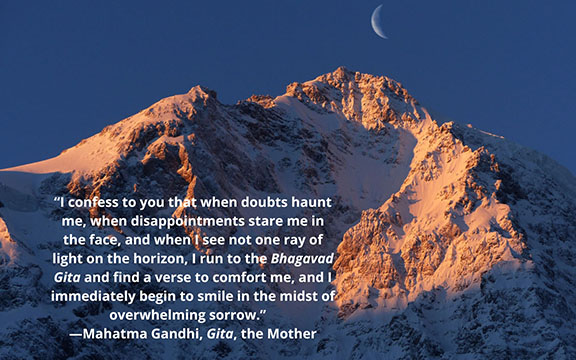 The Himalayas are indeed a crown and spread their victory flag in the sky. The Indian Ocean, in the south, acts as though it washes the feet of the emperor. In between, a thriving sun of culture has been shining for thousands of years over the waves of the Ganga and Yamuna—the divine sun of Sanatana Dharma (Eternal Truth). This cultural beacon has lit the world for millennia. Literature, architecture, beauty, songs, music and dance combine to form the three spiritual pillars of this grand culture: Scriptures, saints, and temples. They are the main reason why it is still alive after so long.
The Himalayas are indeed a crown and spread their victory flag in the sky. The Indian Ocean, in the south, acts as though it washes the feet of the emperor. In between, a thriving sun of culture has been shining for thousands of years over the waves of the Ganga and Yamuna—the divine sun of Sanatana Dharma (Eternal Truth). This cultural beacon has lit the world for millennia. Literature, architecture, beauty, songs, music and dance combine to form the three spiritual pillars of this grand culture: Scriptures, saints, and temples. They are the main reason why it is still alive after so long.
There are many spiritual texts in India, but Shrimad Bhagavad Gita is one of the central Hindu sacred and philosophical texts. It is a national treasure. So great is it, that it is promoted on a large scale, not only in India but all over the world too. Bhagavad Gita is written in Sanskrit and has been translated into every language. Though it is a scripture of Hinduism, it is accepted by all the religions of the world because of its practical and universal teachings. It is said in Gita, “Jnatva Sastravidhanoktam Karma Kartumiharhasi,” which means, Having understood what is stated in the scriptures, act accordingly. If one can really understand what is taught, one can use it in practical fruitfulness in everyday life.
The Bhagavad Gita is the real voice of Sri Krishna. It was spoken in the middle of the battlefield of Mahabharata. The 700-verse scripture is a part of an epic, which recounts the events of an ancient war that occurred at Kurukshetra. It is a conversation between Shri Krishna and Prince Arjuna. Arjuna was in a torn between two contradictory paths of duty due to the ethics and duty (dharma): his cousins, uncles and close friends were fighting on the opposing side. A person who has adopted asceticism (sannyasa), given up worldly desires and prejudices or self-centered weaknesses is different whereas, a person who lives in society and has to do their duties with righteousness and morality often finds themselves in these situations. Under the guidance of Sri Krishna, Arjuna changed his perspective toward life. He was reminded of his duty (dharma).
If a person is not motivated by the desire to acquire the knowledge of a science, they are unfit to study that subject and explaining that particular science is like pouring water on an obverse vessel. Similarly, the teachings of karma (right action) are given to a person who is inspired with a desire of knowing how to perform the right action while leading a life in this world.
For instance, if a person gets stuck in a difficult situation and the science they have learned from rote learning hasn’t helped them to get over it, it is of no use. Therefore, good teachers at first ascertain whether or not the disciple has been inspired by knowledge. If there is no such desire they need to awaken the desire for knowledge.
Arjuna was in a dilemma about his duty and he was ready to give up the war and renounce the world. He was not satisfied by ordinary arguments of abandoning duty and acting weakly. Shri Krishna taught him the science of Karma Yoga. The doubt Arjuna had was not groundless. Today we come across both big and small difficulties in our day-to-day life when considering what to do or what not to do. We all can profit by the practice of Karma Yoga as taught in the Bhagavad Gita.
The word karma comes from the root “kr” which means doing or activity. All the actions that one performs like eating, drinking, sleeping, walking, meditating, desiring, deciding, etc., are all included in the word karma as used in Bhagavad Gita, whether these actions are bodily, vocal, or mental.
The word Yoga is a complicated word. Today, Yoga means physical postures (asanas) or breathing practices. The meaning of this word is not the same in Bhagavad Gita. The word itself comes from “yuj” meaning to join and its root meaning is the state of union. Karma Yoga is a system of ethics intended to help the practitioner realize their union with the Divine; to attain the freedom that comes through unselfishness and by good works. One need not believe in doctrine, ask what a soul is, or even think of metaphysics. If a person has the aim to lead a selfless life, then every moment of their life will be filled with the joy of Oneness. As Swami Satchidananda often said, “The dedicated ever enjoy supreme peace and joy. Therefore, live only to serve.”
About the Author:
 Shweta Goyal is a teacher and a motivational speaker in Australia. Her journey with spirituality started when she faced certain difficulties in her personal life, the answers for which she was unable to find in the scientific world. Having inherited the values of Vedas from her parents, she started reading Vedic history and her perspective toward the same problems that had been bothering her changed, providing her the much-needed peace of mind. Then she realized that the path of spirituality starts where modern science stops giving answers. She decided to go in-depth into the Indian scriptures and it was the Bhagavad Gita that showed her the way to lead her life.
Shweta Goyal is a teacher and a motivational speaker in Australia. Her journey with spirituality started when she faced certain difficulties in her personal life, the answers for which she was unable to find in the scientific world. Having inherited the values of Vedas from her parents, she started reading Vedic history and her perspective toward the same problems that had been bothering her changed, providing her the much-needed peace of mind. Then she realized that the path of spirituality starts where modern science stops giving answers. She decided to go in-depth into the Indian scriptures and it was the Bhagavad Gita that showed her the way to lead her life.

